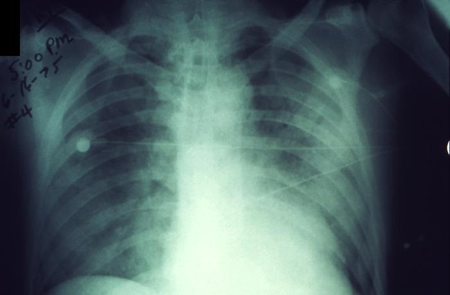Tests
1st tests to order
blood culture (plague)
Test
Recommended for confirmation of diagnosis.[26][28]
Laboratory should be informed if plague is suspected.
Growth on agar is slow and colonies may reach only 1 mm after 48 hours. Characteristic bipolar "safety pin" appearance with Wayson or Wright-Giemsa stain gives a rapid presumptive diagnosis.[26][28]
Antibiotic sensitivity testing may be done at some laboratories.[Figure caption and citation for the preceding image starts]: Bipolar appearance with Wright stainFrom the image collection of the CDC; used with permission [Citation ends].
Result
gram-negative coccobacilli positive
bubo aspirate culture (bubonic plague)
Test
Recommended for confirmation of diagnosis.[26][28]
Laboratory should be informed if plague is suspected.
Cary Blair transport medium maintains viability if transport is required.[28]
Growth on agar is slow and colonies may reach only 1 mm after 48 hours. Characteristic bipolar "safety pin" appearance with Wayson or Wright-Giemsa stain gives a rapid presumptive diagnosis.[26][28]
Antibiotic sensitivity testing may be done at some laboratories.[Figure caption and citation for the preceding image starts]: Bipolar appearance with Wright stainFrom the image collection of the CDC; used with permission [Citation ends].
Result
gram-negative coccobacilli positive
sputum culture (pneumonic plague)
Test
Recommended for confirmation of diagnosis.[26][28]
Laboratory should be informed if plague is suspected.
Cary Blair transport medium maintains viability if transport is required.[28]
Growth on agar is slow and colonies may reach only 1 mm after 48 hours. Characteristic bipolar "safety pin" appearance with Wayson or Wright-Giemsa stain gives a rapid presumptive diagnosis.[26][28]
Antibiotic sensitivity testing may be done at some laboratories.[Figure caption and citation for the preceding image starts]: Bipolar appearance with Wright stainFrom the image collection of the CDC; used with permission [Citation ends].
Result
gram-negative coccobacilli positive
cerebrospinal fluid culture (septicemic plague)
Test
Recommended for confirmation of diagnosis.[26][28]
Indicated if meningeal symptoms are present.
Laboratory should be informed if plague is suspected.
Cary Blair transport medium maintains viability if transport is required.[28]
Growth on agar is slow and colonies may reach only 1 mm after 48 hours. Characteristic bipolar "safety pin" appearance with Wayson or Wright-Giemsa stain gives a rapid presumptive diagnosis.
Antibiotic sensitivity testing may be done at some laboratories.[Figure caption and citation for the preceding image starts]: Bipolar appearance with Wright stainFrom the image collection of the CDC; used with permission [Citation ends].
Result
gram-negative coccobacilli positive
throat swab specimen culture (pharyngeal plague)
Test
Recommended for confirmation of diagnosis.[26][28]
Laboratory should be informed if plague is suspected.
Growth on agar is slow and colonies may reach only 1 mm after 48 hours. Characteristic bipolar "safety pin" appearance with Wayson or Wright-Giemsa stain gives a rapid presumptive diagnosis.[26][28]
Antibiotic sensitivity testing may be done at some laboratories.
[Figure caption and citation for the preceding image starts]: Bipolar appearance with Wright stainFrom the image collection of the CDC; used with permission [Citation ends].
Result
gram-negative coccobacilli positive
antigen detection (plague)
Test
A rapid diagnostic test against F1 antigen is available and is widely used in Africa and South America. A positive test is considered presumptive evidence of plague.[28]
Performed on sputum from patients with suspected pneumonic plague, or bubo aspirate from patients with suspected bubonic plague. The result is usually available within 15 minutes and is easy to interpret.[1]
These tests appear to be sensitive when compared to culture but poor specificity means false positive results are possible. The quality of evidence supporting the use of rapid diagnostic tests is low and culture is still necessary for diagnosis, as well as providing information on antimicrobial resistance and prevalent strains.[31]
The World Health Organization recommends in the following circumstances: people with suspected pneumonic or bubonic plague in endemic areas in order to rapidly detect disease and implement an immediate public health response (confirmatory testing is required before declaring an outbreak); and people with suspected pneumonic or bubonic plague during an outbreak to provide rapid diagnosis at the point of care (a confirmatory test should be carried out at the same time).[1]
Result
Yersinia pestis positive
WBC count (plague)
Test
Nonspecific test.
Result
elevated (10,000 to 20,000 cells/mm³)
chest x-ray (pneumonic plague)
Test
Pneumonic plague may appear as either unilateral or bilateral consolidation or alveolar infiltrates. Pleural effusion and hilar/mediastinal adenopathy have also been described.[32][Figure caption and citation for the preceding image starts]: Plague infection involving both lung fieldsFrom the image collection of the CDC; used with permission [Citation ends].
Result
unilateral or bilateral consolidation or alveolar infiltrates
stool culture (yersiniosis)
Test
Both organisms grow well on MacConkey agar, but colonies are small at 24 hours and may be overgrown by other flora. Selective media such as cefsulodin-Irgasan-novobiocin incubated at room temperature improve yield.[30]
Result
Yersinia enterocolitica or Yersinia pseudotuberculosis positive
Tests to consider
serology (plague or yersiniosis)
Test
Recommended to confirm diagnosis, particularly if cultures are negative and plague is still suspected.[26][28]
Acute and convalescent sera can be tested for antibody to the F1 antigen of Yersinia pestis by passive hemagglutination. Convalescent serum should be taken 4-6 weeks after disease onset. A fourfold increase between acute and convalescent titers is considered diagnostic.[26][28] Serology may be positive even if cultures are negative.
Serology testing for Yersinia enterocolitica and Yersinia pseudotuberculosis is not widely available in the US, but it is used in Europe. Results may be difficult to interpret because of relatively high seropositivity in the general population and cross-reactivity with Salmonella, Brucella, and Rickettsia species.[33]
Result
Fourfold increase between acute and convalescent titers
polymerase chain reaction (plague)
Test
Recommended for confirmation of diagnosis of plague, when available, particularly if cultures are negative and plague is still suspected.[26][28] While polymerase chain reaction may provide more rapid detection, it does not replace the requirement for microscopy and culture.
Result
Yersinia pestis positive
Use of this content is subject to our disclaimer